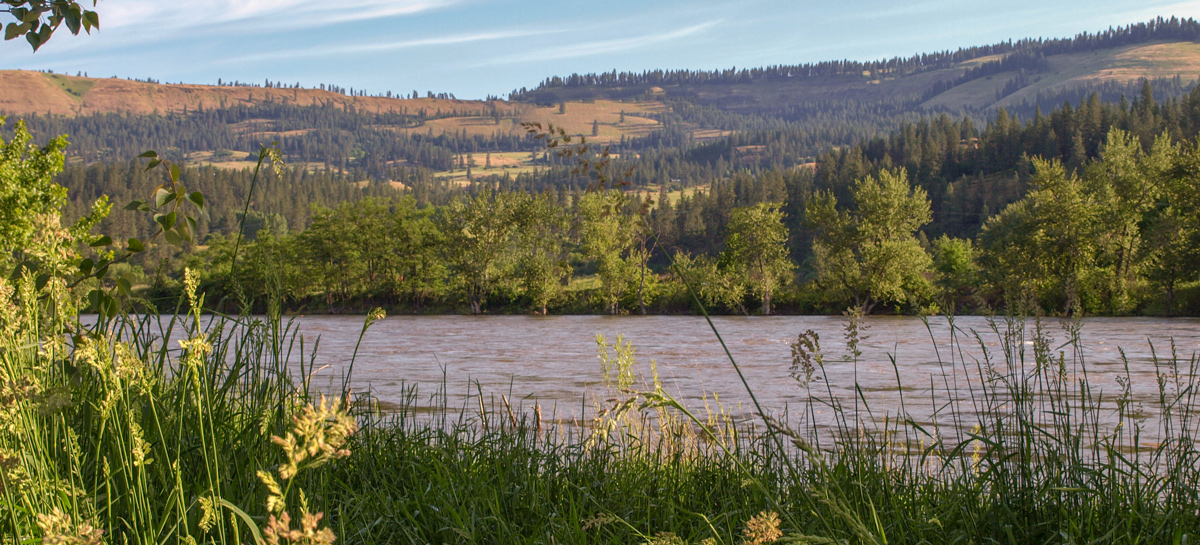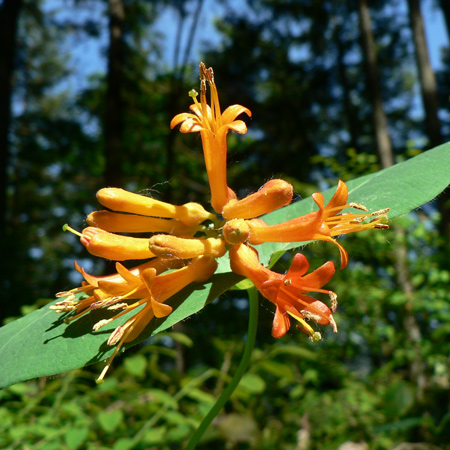A Nez Perce man reports that he was unable to cross the Bitterroot Mountains due to snow and toddler Jean Baptiste is given a new medical treatment. Lewis describes Long Camp area grasses and collects two plants: the trumpet honeysuckle (Lonicera ciliosa) and silky lupine (Lupinus sericeus).
Grass
by Yellowstone Public Radio[1]Originally aired weekdays by Yellowstone Public Radio during the Bicentennial observance of 2003-2006. Narrated by Hal Hansen. Scripts by Whit Hansen and Ed Jacobson. Produced by Leni Holliman. © … Continue reading
Clearwater River at Long Camp
© 7 June 2009 by Kristopher K. Townsend. Permission to use granted under the Creative Commons Attribution-Share Alike 4.0 International license.
Above: The Clearwater River is running very high from snow melt and the previous day’s heavy rains. Long Camp was across the river and just to the left of this photo. Grasses that Lewis described on this day can be seen on the near shore.
Jean Baptiste’s New Medicine
the child is recovering fast the inflamation has subsided intirely, we discontinued the poltice, and applyed a plaster of basilicon; the part is still considerably swolen and hard.
—Meriwether Lewis
Mountains Blocked by Snow
In the afternoon four hunters came in with the meat of five more deer, and a bear. An Indian came with them, who had been part of the way over the mountains; but found the road too bad and the snow too deep to cross; so we are obliged to remain where we are sometime longer.
—Patrick Gass
Area Grasses
among the grasses of this country I observe a large speceis which grows in moist situations . . . . a second speceis grows in tussucks and rises to the hight of six or eight feet . . . . a third speceis resembles the cheet, tho’ the horses feed on it very freely. a fourth and most prevalent speceis is a grass which appears to be the same called the blue grass common to many parts of the United States;
—Meriwether Lewis
Observing Equal Altitudes
Observed equal Altitudes of the sun with Sextant.
—Meriwether Lewis
Trumpet Honeysuckle
Lonicera ciliosa
© 31 May 2007 by Kristopher K. Townsend. Permission to use granted under the Creative Commons Attribution-Share Alike 4.0 International license.
Trumpet Honeysuckle
yellow; On the Kooskooskee [Clearwater] Jun: 5th 1806
—Meriwether Lewis[2]Lonicera ciliosa. Moulton, ed. Herbarium, specimen 100.
Silky Lupine
New Species Flowers cream colored with a Small fringe of blue. On the Kooskooskee Jun 5th 1806
—Meriwether Lewis[3]Lupinus sericeus. Moulton, ed. Herbarium, specimen 102.
Weather Diary
State of the weather at rise
Wind at rise
State of the weather at 4 P.M. Wind at 4 P.M. State of the Kooskooskee at rise
fair S E. fair N W raised 4 in. last night was colder than usual but no frost.— the river fell 3½ inches in the course of the day and raised 4 I. last night as [s]tated in the diary. this fluctuating state of the river no doubt is caused by the influence of the sun in the course of the day on the snows of the mountains; the accession of water thus caused in the day dose not reach us untill night when it produces a rise in the river.— The wild roots is in blume. the river fell 10 Ins. in the course of this day.
—Meriwether Lewis[4]To assist the reader of this web page, the date column is not presented, the river columns have been merged, and some abbreviations have been spelled out.
Experience the Lewis and Clark Trail
The Lewis and Clark Trail Experience—our sister site at lewisandclark.travel—connects the world to people and places on the Lewis and Clark Trail.
Plan a trip related to June 5, 1806:

Notes
| ↑1 | Originally aired weekdays by Yellowstone Public Radio during the Bicentennial observance of 2003-2006. Narrated by Hal Hansen. Scripts by Whit Hansen and Ed Jacobson. Produced by Leni Holliman. © 2003 by Yellowstone Public Radio. |
|---|---|
| ↑2 | Lonicera ciliosa. Moulton, ed. Herbarium, specimen 100. |
| ↑3 | Lupinus sericeus. Moulton, ed. Herbarium, specimen 102. |
| ↑4 | To assist the reader of this web page, the date column is not presented, the river columns have been merged, and some abbreviations have been spelled out. |


